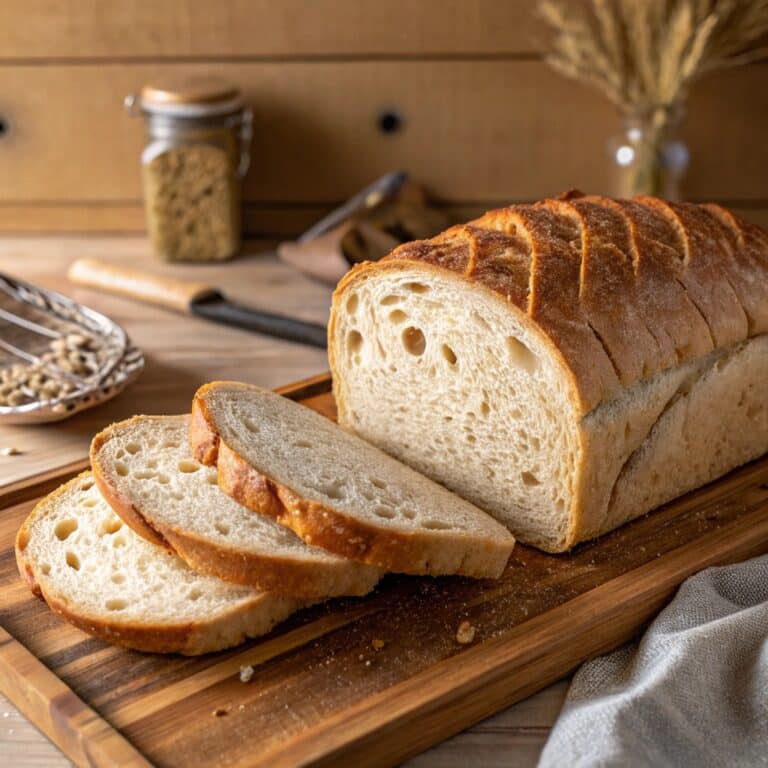Sourdough sandwich bread has quickly become a favorite in kitchens across the USA. Unlike rustic artisan sourdough with its crunchy crust and open crumb, sourdough sandwich bread is soft, fluffy, and shaped perfectly for stacking your favorite fillings. In this guide, we’ll explore the key differences between sourdough bread and sourdough sandwich bread, why it makes an excellent base for sandwiches, the most common mistakes beginners face, and which sandwiches truly shine with sourdough. You’ll also learn tips for baking at home, storage advice, and recipe inspiration.
Looking for inspiration? Try sourdough discard pizza dough to complement your sandwich-making journey.
Table of Contents
Understanding Sourdough Sandwich Bread
Sourdough sandwich bread is more than just another loaf it’s the perfect middle ground between rustic artisan sourdough and everyday sandwich bread. To really understand why it stands out, you need to look at the fermentation process, structure, and how it’s crafted differently from other types of bread. Let’s break it down.
What Makes Sourdough Different from Regular Bread?
Most supermarket sandwich breads are made with commercial yeast. This quick-rise yeast does its job fast, producing fluffy loaves in just a few hours. Sourdough, on the other hand, uses a natural starter a mixture of wild yeast and lactic acid bacteria. This fermentation process is slower, usually taking several hours or even overnight. The result? A more complex flavor that’s slightly tangy, with a deeper aroma and texture.
Regular sandwich bread tends to be uniform, mild, and soft, while sourdough sandwich bread keeps the best of both worlds: the nutrition and flavor of sourdough, with the tender crumb of sandwich bread. That’s what makes it ideal for stacking fillings without overwhelming your taste buds.
The Role of Natural Fermentation in Flavor and Texture
The slow fermentation in sourdough does more than just add flavor. It breaks down gluten and phytic acid, making the bread easier to digest. That’s one reason why some people who struggle with regular bread find sourdough more gut-friendly.
Texture also changes dramatically. In artisan loaves, fermentation creates an open crumb with large, uneven holes. Great for dipping in olive oil, but not so great when mayonnaise drips through your sandwich. Sourdough sandwich bread is shaped in a pan, which encourages a more even crumb structure smaller holes and softer slices that hold fillings securely.
Comparing Artisan Sourdough vs. Sourdough Sandwich Bread
It’s easy to confuse the two since they share the same base ingredients, but here’s where they differ:
| Feature | Artisan Sourdough | Sourdough Sandwich Bread |
|---|---|---|
| Crust | Thick, crunchy | Thin, soft |
| Crumb | Open, airy, irregular holes | Even, soft, smaller holes |
| Shape | Round or oval, baked free-form | Rectangular, baked in loaf pan |
| Use | Soups, toasts, dipping | Sandwiches, melts, kids’ lunches |
So, if you’ve ever struggled to fit slices of artisan sourdough into your toaster or keep your sandwich fillings in place, sourdough sandwich bread solves that problem.
Don’t miss our high fiber sourdough guide if you’d like to try boosting the nutrition of your sandwich loaves while keeping that soft, chewy bite.
Print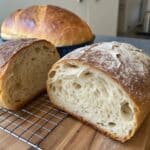
Sourdough Sandwich Bread
- Total Time: 4–6 hours
- Yield: 1 loaf (10–12 slices)
Description
Soft, fluffy, and tangy sourdough sandwich bread baked in a loaf pan, perfect for stacking sandwiches, toasting, or enjoying fresh.
Ingredients
- 500g bread flour (or a mix of 75% bread flour, 25% whole wheat)
- 300ml water or milk (60–65% hydration)
- 100g active sourdough starter
- 10g salt
- 30g butter or olive oil (optional, for softness)
- 20g honey or sugar (optional, for sweetness)
Instructions
- Feed your sourdough starter 4–6 hours before baking until bubbly and active.
- Mix starter, water (or milk), flour, and salt. Add butter and honey after autolyse.
- Let dough bulk ferment for 3–4 hours, folding every 30 minutes.
- Shape into a log and place in a greased loaf pan.
- Proof 2–4 hours until dough rises 1 inch above the pan rim.
- Bake at 375°F (190°C) for 35–40 minutes.
- Brush with melted butter after baking for a softer crust.
- Cool completely before slicing.
Notes
Use 60–65% hydration for a soft crumb. For longer freshness, slice and freeze portions, reheating when needed.
- Prep Time: 20 minutes (plus fermentation time)
- Cook Time: 40 minutes
- Category: Bread
- Method: Baked
- Cuisine: American
Key Features of Sourdough Sandwich Bread
Sourdough sandwich bread has become a staple in many American kitchens not just because of its flavor, but because it checks every box for a great sandwich loaf: soft enough to bite through, sturdy enough to hold fillings, and flavorful enough to elevate even the simplest sandwich. Let’s dive into the defining features that make it stand out.
Why a Soft Crumb Matters for Sandwiches
One of the biggest complaints about artisan sourdough is that its crumb (the inside structure of the bread) can be too open and chewy for sandwiches. While that rustic texture looks beautiful, it isn’t practical when your mustard, tomato juice, or melted cheese drips through the holes.
Sourdough sandwich bread, by contrast, is intentionally baked for a softer, tighter crumb. The texture is tender, with smaller air pockets, which makes it ideal for:
- Kids’ lunches – soft enough for PB&J without tearing.
- Layered sandwiches – like a turkey club, where you need slices that hold together.
- Toasting – the even structure browns beautifully in the toaster without crumbling.
The soft crumb also enhances the mouthfeel, giving you that classic sandwich experience with an extra tang from the sourdough fermentation.
Shaping Techniques for a Loaf Pan vs. Freeform Baking
The way sourdough sandwich bread is shaped makes a huge difference. Artisan sourdough is usually shaped into a boule (round) or batard (oval) and baked directly on a stone or tray, which leads to a thick crust and uneven shape.
Sourdough sandwich bread, however, is shaped into a loaf pan. This creates a uniform rectangle, perfect for slicing. The walls of the pan also encourage a thinner, softer crust exactly what you want for a sandwich.
If you prefer a lighter sandwich loaf, you can also enrich the dough with milk or butter before shaping. This gives the bread a pillowy interior, closer to what you’d expect from classic store-bought bread but with the superior flavor of sourdough.
Achieving a Tender Crust Without Losing Flavor
One hallmark of sandwich bread is a crust that doesn’t overwhelm the fillings. While many people love the crunch of artisan sourdough, a softer crust is better for sandwiches. You can achieve this without sacrificing taste by:
- Using milk or butter in the dough – this tenderizes the crust.
- Brushing the loaf with melted butter after baking – adds softness and flavor.
- Controlling oven steam – too much steam creates a crisp crust, while minimal steam produces a thinner, softer finish.
The result is bread that slices easily, won’t scrape the roof of your mouth, and still delivers that classic sourdough tang.
Check out gluten-free sourdough bread if you’d like to adapt these same principles for a gluten-free version while still enjoying sandwich-ready slices.
Ingredients that Define Sourdough Sandwich Bread
When it comes to baking sourdough sandwich bread, the ingredients you choose make a dramatic difference in the final loaf. Unlike rustic artisan sourdough, which leans on flour, water, and salt alone, sandwich bread often includes enriching ingredients that make it softer, more flavorful, and easier to slice. Let’s explore the key elements.
Flour Choices: Whole Wheat, White, or a Blend
The type of flour you use sets the foundation of your loaf:
- Bread flour (high-protein white flour): Gives structure and chewiness. Most bakers choose this for sandwich bread because it helps create a sturdy, yet soft loaf.
- All-purpose flour: Works fine, but the lower protein means less chew and sometimes a denser texture.
- Whole wheat flour: Adds nutty flavor and more fiber but can make bread denser. Many bakers use a 70/30 or 50/50 mix with white flour for balance.
- Specialty flours: Rye, spelt, or einkorn add depth of flavor, though they may need blending to keep the crumb light.
Choosing the right blend depends on whether you want a more traditional white sandwich loaf or something heartier. For a balanced approach, many home bakers use 75% bread flour and 25% whole wheat.
Hydration Levels and How They Affect Texture
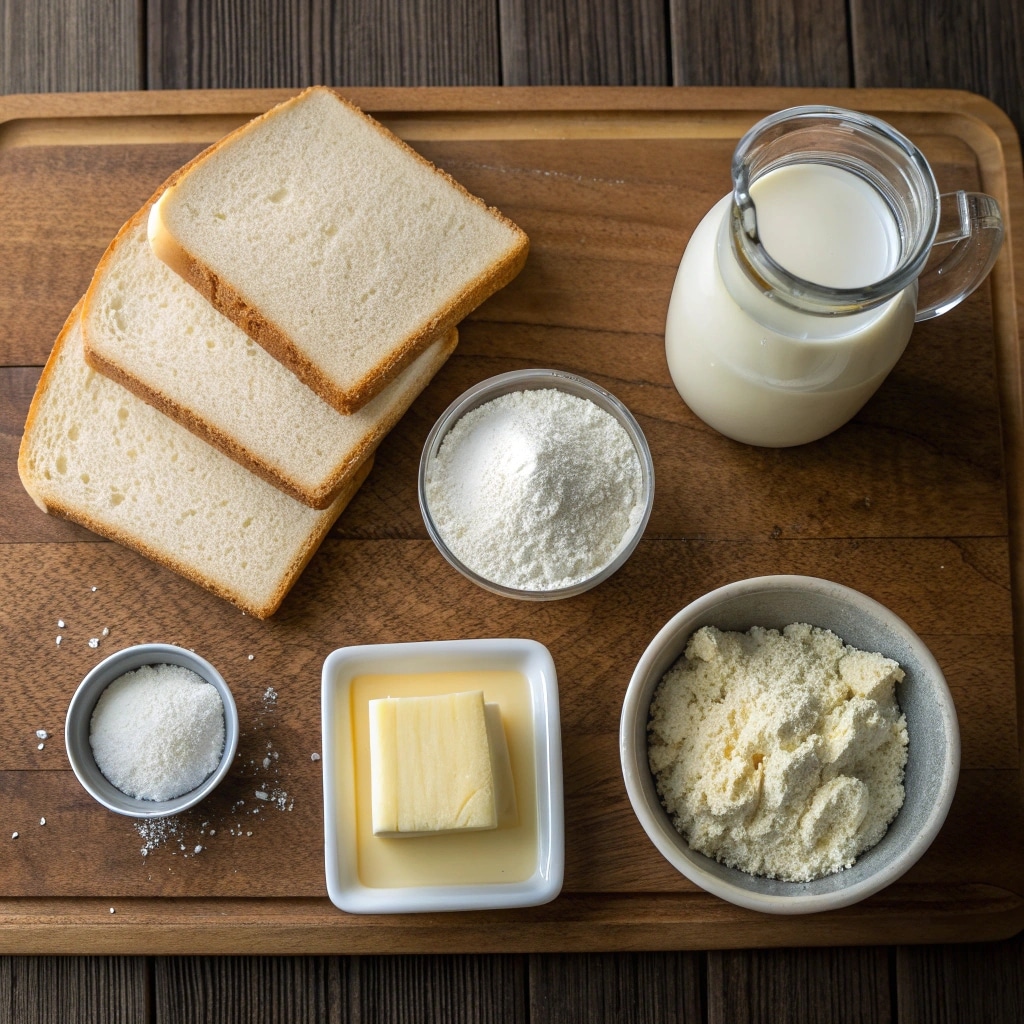
Hydration refers to the ratio of water to flour in your dough. Artisan sourdoughs often use 70–80% hydration, leading to that open, holey crumb. Sourdough sandwich bread, however, works best in the 60–65% range. This creates a dough that’s easier to handle, bakes into a soft, even crumb, and slices neatly.
Here’s a quick comparison:
| Hydration | Texture | Best Use |
|---|---|---|
| 60–65% | Soft, even crumb | Sandwich loaves |
| 70–75% | Airy, open crumb | Rustic sourdough |
| 80%+ | Very holey, artisan style | Boules, batards |
Lower hydration doesn’t mean less flavor it simply gives you the structure you want for practical sandwich bread.
Enhancers: Milk, Honey, and Butter for Softness
What separates sandwich bread from artisan loaves are the enrichments that make it tender and flavorful. These aren’t required but can take your bread to the next level:
- Milk: Softens the crumb and crust, adds richness. Whole milk works best, but you can also use dairy-free milk alternatives.
- Butter or oil: Provides tenderness and helps bread stay fresh longer.
- Honey or sugar: Adds a touch of sweetness and helps with browning.
- Eggs (optional): Increase richness and color but aren’t essential.
Think of these ingredients as your “secret weapons” for creating that bakery-style sandwich loaf that feels indulgent without being heavy.
If you love creative twists, don’t miss our pickle sandwich a fun way to see how the right bread transforms even the most playful fillings.
Baking the Perfect Loaf at Home
Baking sourdough sandwich bread at home may sound intimidating, but once you understand the process, it becomes a rewarding routine. Unlike rustic sourdough, the sandwich loaf is less about achieving a dramatic crust and open crumb and more about creating consistency, softness, and sliceability. Here’s how to get it right from start to finish.
Step-by-Step Process from Starter to Baked Bread
- Feed Your Starter
A healthy sourdough starter is the backbone of your bread. Feed it 4–6 hours before mixing so it’s bubbly and active. It should pass the float test (a spoonful floats in water). - Mix the Dough
Combine starter, water (or milk if enriching), flour, and salt. If using butter, oil, or honey, incorporate them after autolyse (the resting period) so the gluten develops first. - Bulk Fermentation
Let the dough rest at room temperature for 3–4 hours, stretching and folding every 30 minutes. This builds structure without heavy kneading. - Shape the Loaf
Gently degas the dough and shape it into a log to fit snugly in a greased loaf pan. Smooth out the top for an even rise. - Final Proof
Cover and let rise until the dough crowns about 1 inch above the pan. This usually takes 2–4 hours depending on your kitchen temperature. - Bake
Bake at 375°F (190°C) for 35–40 minutes. For a softer crust, skip steam in the oven. Brush the loaf with butter right after baking for extra tenderness.
How Long to Proof for Optimal Rise
Proofing is where many bakers go wrong. Underproof, and your bread will burst oddly in the oven. Overproof, and it may collapse. The sweet spot? When the dough has doubled in size and springs back slowly when pressed with a fingertip.
For beginners, using the loaf pan as a guide helps: the dough should rise slightly above the rim before baking.
Baking Times and Temperature Guidelines
Getting the bake right ensures your loaf is cooked through but not dry:
| Oven Temp | Bake Time | Result |
|---|---|---|
| 375°F (190°C) | 35–40 min | Soft crust, tender crumb |
| 400°F (205°C) | 30–35 min | Slightly firmer crust |
| With steam | Varies | Not recommended for sandwich loaves (creates crunchy crust) |
Tip: Always check for doneness by tapping the bottom of the loaf it should sound hollow. Or, use a thermometer: the internal temperature should reach 190–200°F.
Don’t miss our cloud bread breakfast sandwich for a lighter alternative if you want to compare textures and styles of bread used for sandwiches.
Common Beginner Mistakes with Sourdough Bread
Baking sourdough sandwich bread at home can feel like a science experiment, and beginners often run into the same roadblocks. The good news? Every mistake teaches you something about how sourdough works. Here are the most common pitfalls and how to sidestep them.
Overproofing and Underproofing Explained
Proofing is one of the trickiest parts of sourdough.
- Overproofing happens when the dough ferments too long. The wild yeast runs out of food, and the gluten structure weakens. The result? A loaf that rises beautifully in the pan but collapses in the oven, leaving you with a gummy or flat center.
- Underproofing is the opposite the dough hasn’t fermented enough. You’ll notice tight crumb, poor oven spring, and sometimes a dense texture.
Solution: Use the poke test. Gently press the dough with a finger:
- If it springs back immediately → underproofed.
- If it doesn’t spring back at all → overproofed.
- If it springs back slowly → perfectly proofed.
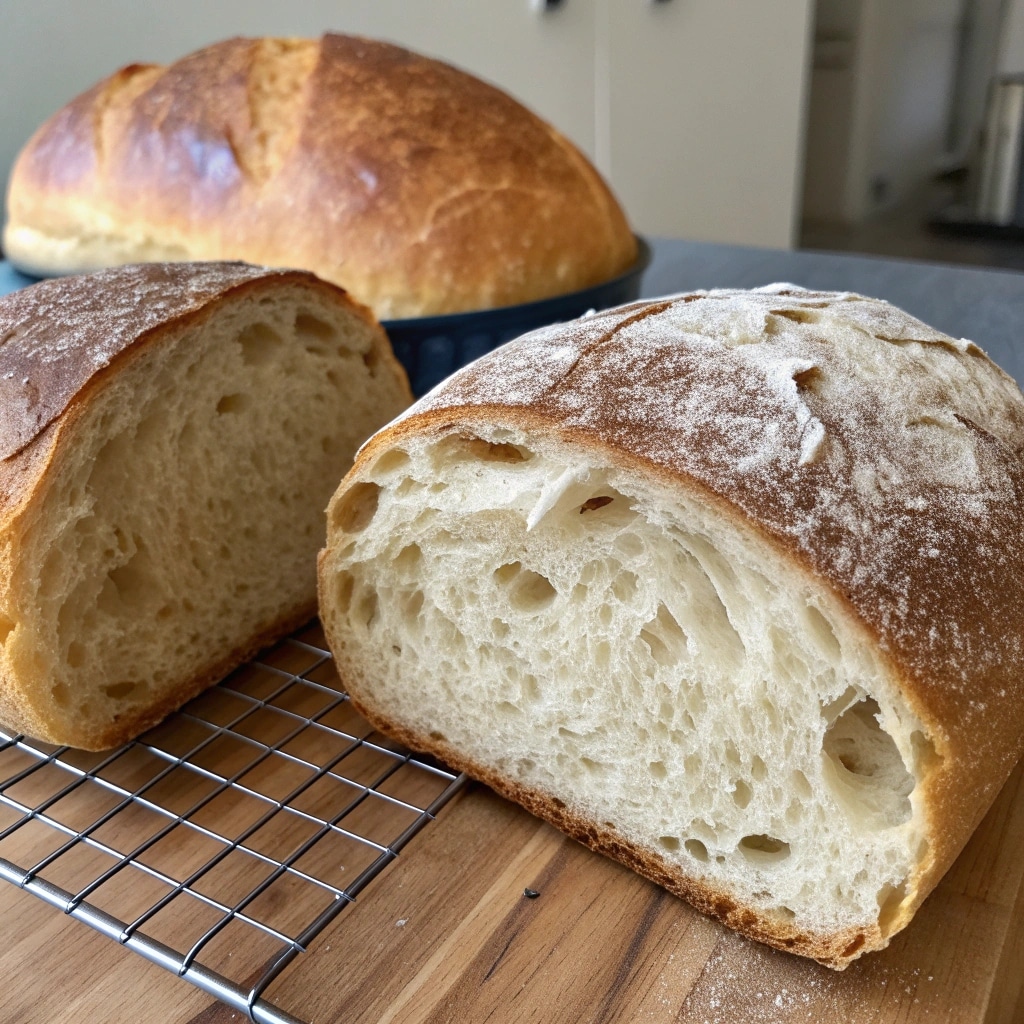
Why Dense Bread Happens and How to Fix It
Few things are more discouraging than slicing into your loaf and finding it heavy and dense instead of soft and fluffy. The most common causes are:
- Starter not active enough → weak yeast activity, little rise.
- Too much flour during shaping → toughens the dough.
- Not enough hydration → dry, tight crumb.
Fix: Make sure your starter is bubbly and passes the float test, and resist the urge to keep adding flour when handling sticky dough. A little tackiness is normal and helps the bread stay moist.
Handling Sticky Dough Without Extra Flour
Beginners often panic when dough sticks to their hands or counter. Adding too much flour can throw off hydration and make bread dense. Instead, try these tricks:
- Wet your hands before touching the dough.
- Use a bench scraper to fold and lift.
- Work quickly dough sticks less if you don’t linger.
Over time, you’ll get used to handling sticky dough with confidence, and that’s when your loaves really start to improve.
Don’t miss our sourdough discard biscuits if you want a quick, forgiving way to practice working with sourdough doughs without the long fermentation times.
Why Sourdough Sandwich Bread Works for Sandwiches
When you think about the perfect sandwich, the bread isn’t just a carrier it’s half the experience. The tangy flavor, soft crumb, and light crust of sourdough sandwich bread make it one of the best choices for stacking your favorite fillings. Here’s why this style of bread shines.
Balancing Flavor with Fillings
Artisan sourdough loaves are known for their sharp tang, thick crust, and chewy texture. While delicious, those traits can sometimes overpower sandwich fillings or make biting into a sandwich a bit of a jaw workout.
Sourdough sandwich bread, however, is milder in flavor and has a softer crust, which allows the fillings to take center stage. Instead of fighting with the bread, your turkey, ham, avocado, or cheese blend seamlessly with it. The sourdough tang enhances flavors without overshadowing them, making it versatile for both savory and sweet sandwiches.
Nutritional Benefits of Sourdough in Sandwiches
Another reason sourdough sandwich bread is a winner? Its health perks. Natural fermentation doesn’t just add flavor it also boosts nutrition:
- Easier digestion: The wild yeast and lactic acid bacteria break down gluten and phytic acid, making nutrients more bioavailable.
- Lower glycemic impact: Sourdough bread tends to spike blood sugar less compared to regular white bread.
- Rich in beneficial compounds: Lactic acid bacteria produce antioxidants and may support gut health.
That means when you reach for sourdough instead of standard sandwich bread, you’re choosing something that’s not just tastier but potentially healthier too.
Does Sourdough Keep Sandwiches Fresh Longer?
Yes, and here’s why: the acidity in sourdough naturally slows down mold growth. That means your loaf stays fresher longer than typical store-bought bread with no preservatives. For sandwiches, this is a big win your packed lunch won’t dry out as quickly, and leftovers hold up well in the fridge.
If you love bold flavor pairings, don’t miss our pickle sandwich a quirky but delicious recipe that proves just how versatile sourdough sandwich bread can be.
Best Sandwiches to Make with Sourdough Bread
One of the biggest joys of baking sourdough sandwich bread is experimenting with all the delicious fillings it can hold. Thanks to its soft crumb and mild tang, it pairs beautifully with both classic comfort sandwiches and more gourmet creations. Let’s explore some of the best.
Classic Pairings: Grilled Cheese, Turkey, and BLTs
- Grilled Cheese: Sourdough sandwich bread takes grilled cheese to the next level. The bread crisps evenly while the tang balances the richness of melted cheddar, mozzarella, or a blend of cheeses.
- Turkey & Swiss: A deli-style favorite where the mild sourdough enhances roasted turkey, creamy Swiss cheese, and a smear of mustard or mayo.
- BLT: Crisp bacon, juicy tomatoes, fresh lettuce, and a hint of mayo when layered on sourdough, every bite has the perfect balance of crunch and tang.
These classics showcase how sourdough can elevate familiar flavors without overshadowing them.
Gourmet Options: Smoked Salmon, Caprese, and Avocado Toasts
For those who love something a little fancier, sourdough sandwich bread works beautifully in gourmet combinations:
- Smoked Salmon & Cream Cheese: Add cucumber slices, red onion, and fresh dill for a bagel-inspired twist.
- Caprese Sandwich: Fresh mozzarella, tomato, and basil drizzled with balsamic glaze light, refreshing, and bursting with flavor.
- Avocado Toast Variations: While technically open-faced, sourdough’s tangy flavor pairs perfectly with smashed avocado, chili flakes, or a poached egg on top.
These options show how versatile sourdough sandwich bread can be, adapting to light, refreshing meals as well as rich, indulgent ones.
Creative Sandwich Ideas for Kids and Families
Sourdough sandwich bread isn’t just for adults it works wonderfully for family meals too:
- PB&J Upgrade: The soft crumb holds peanut butter and jelly without soaking through, and the slight tang balances the sweetness.
- Mini Pizza Sandwiches: Spread tomato sauce, add mozzarella and pepperoni, then toast for a kid-friendly lunch.
- Chicken Salad or Egg Salad Sandwiches: The sturdiness of sourdough ensures these creamy fillings don’t fall apart.
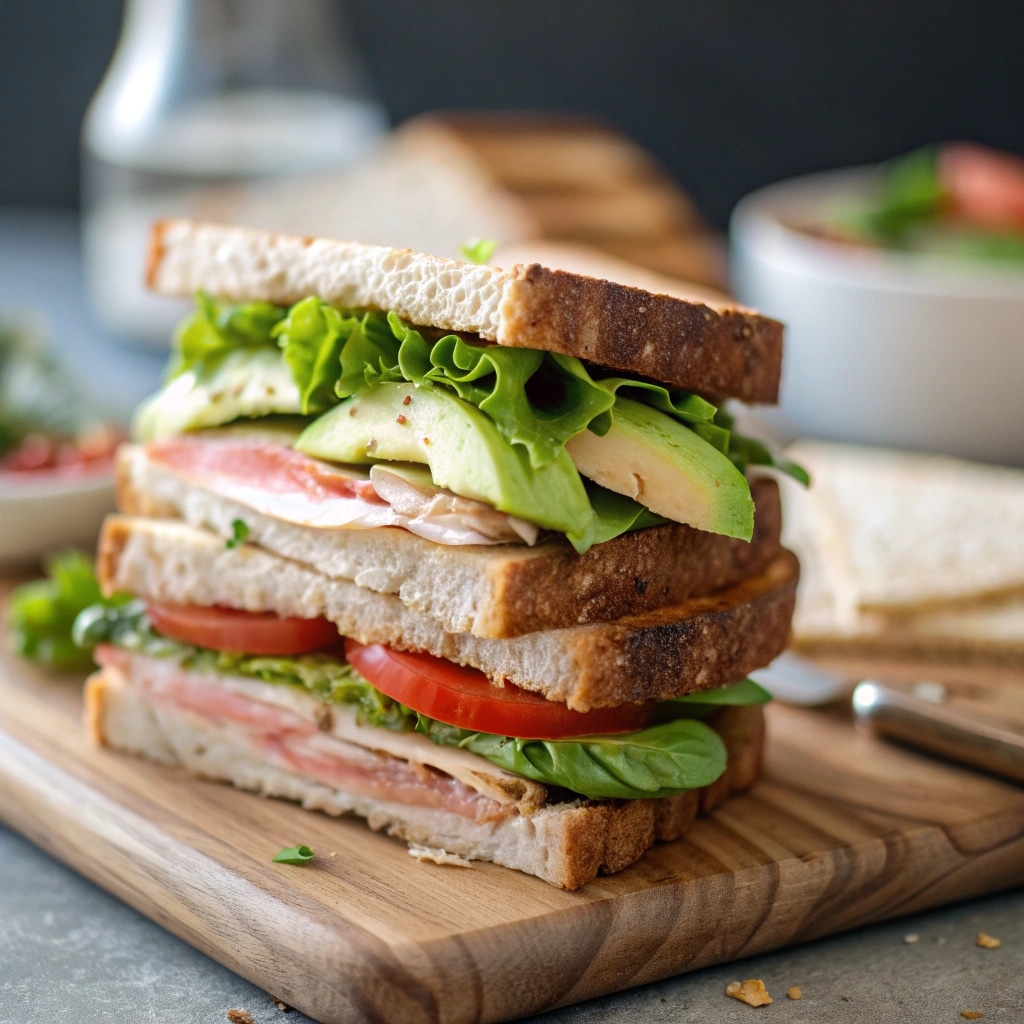
And for busy mornings, sourdough sandwich bread is fantastic for quick toast with spreads or breakfast sandwiches.
Check out our sourdough discard pizza dough if you’d like another fun way to experiment with sourdough for family meals it’s just as flexible as sandwich bread.
Storage and Serving Tips for Sourdough Sandwich Bread
You’ve baked (or bought) a beautiful loaf of sourdough sandwich bread now the key is keeping it fresh and serving it at its best. Unlike store-bought bread, sourdough has no preservatives, so a little care goes a long way.
Best Ways to Store Fresh Sourdough Sandwich Bread
- Room Temperature (short term): Keep your loaf in a paper bag, bread box, or wrapped in a clean kitchen towel. This allows airflow, which prevents mold but keeps the crust from getting too soft. Avoid plastic bags unless you prefer a softer crust.
- Fridge? Not Ideal: Refrigeration dries bread quickly and can make it stale faster. It’s better to freeze slices if you won’t eat the loaf within a few days.
Freezing and Reheating Slices
If you’ve baked a big loaf, freezing is the best way to extend its life.
- Slice before freezing so you can grab only what you need.
- Wrap slices in parchment, then place in a freezer bag.
- Reheat straight from frozen in a toaster, or let thaw at room temperature.
This keeps the bread soft inside while preserving its tangy flavor.
Should You Toast It or Serve It Soft?
- Toast it for sandwiches with moist fillings (like tuna salad, tomatoes, or avocado). The crispiness holds up better and prevents sogginess.
- Keep it soft for PB&J, ham and cheese, or kids’ sandwiches where you want tender bites.
- Grill it for paninis or grilled cheese sourdough sandwich bread browns beautifully.
For a fun twist on serving, try making sourdough pita chips. They’re crispy, tangy, and perfect for dips or snacking proof that sourdough isn’t just for loaves.
Conclusion + Quick FAQ Recap
Sourdough sandwich bread is more than just a loaf it’s a balance of tangy flavor, tender crumb, and the right shape for everyday sandwiches. Unlike rustic sourdough boules, sandwich loaves are baked in pans for a soft, sliceable structure that makes them versatile for breakfast toast, deli-style sandwiches, and even gourmet grilled cheese.
When baked and cared for properly, sourdough sandwich bread brings together the best of both worlds: the health benefits of natural fermentation and the convenience of a perfectly sized sandwich slice. Whether you’re a beginner or a seasoned baker, keeping an eye on fermentation times, hydration levels, and shaping techniques will help you avoid common mistakes and bake with confidence.
For storing, remember: keep it at room temperature for short-term use, freeze slices for later, and toast when you need that extra crunch. Pair it with classics like turkey and cheese, or go bold with avocado BLTs and artisan grilled sandwiches the options are endless.
Now, let’s quickly revisit the most asked questions:
What’s the difference between sourdough bread and sourdough sandwich bread?
Sourdough bread is often round, crusty, and rustic, while sourdough sandwich bread is baked in a loaf pan for a softer, slice-friendly crumb.
Does sourdough make good sandwich bread?
Yes—its sturdy yet soft texture and complex flavor make it one of the best breads for sandwiches.
What is the biggest mistake beginners make with sourdough bread?
Not managing fermentation properly. Over-proofing or under-proofing can ruin texture and rise.
What are the best sandwiches to make with sourdough bread?
Grilled cheese, turkey and avocado, BLTs, tuna melts, and even PB&J shine when made with sourdough sandwich bread.
If you love sourdough, don’t miss trying sourdough discard pizza dough for a tangy twist on homemade pizza, or experiment with gluten-free sourdough bread if you’re exploring alternative flours. Looking for inspiration? Try sourdough discard English muffins for breakfast or whip up sourdough discard biscuits as a quick comfort side.
By now, you know how to bake, slice, store, and enjoy sourdough sandwich bread in every way possible. So whether you’re packing lunches or planning a cozy weekend brunch, your loaf is ready to shine.
Follow us on Facebook: Recipe by Clara – Official Facebook Page

